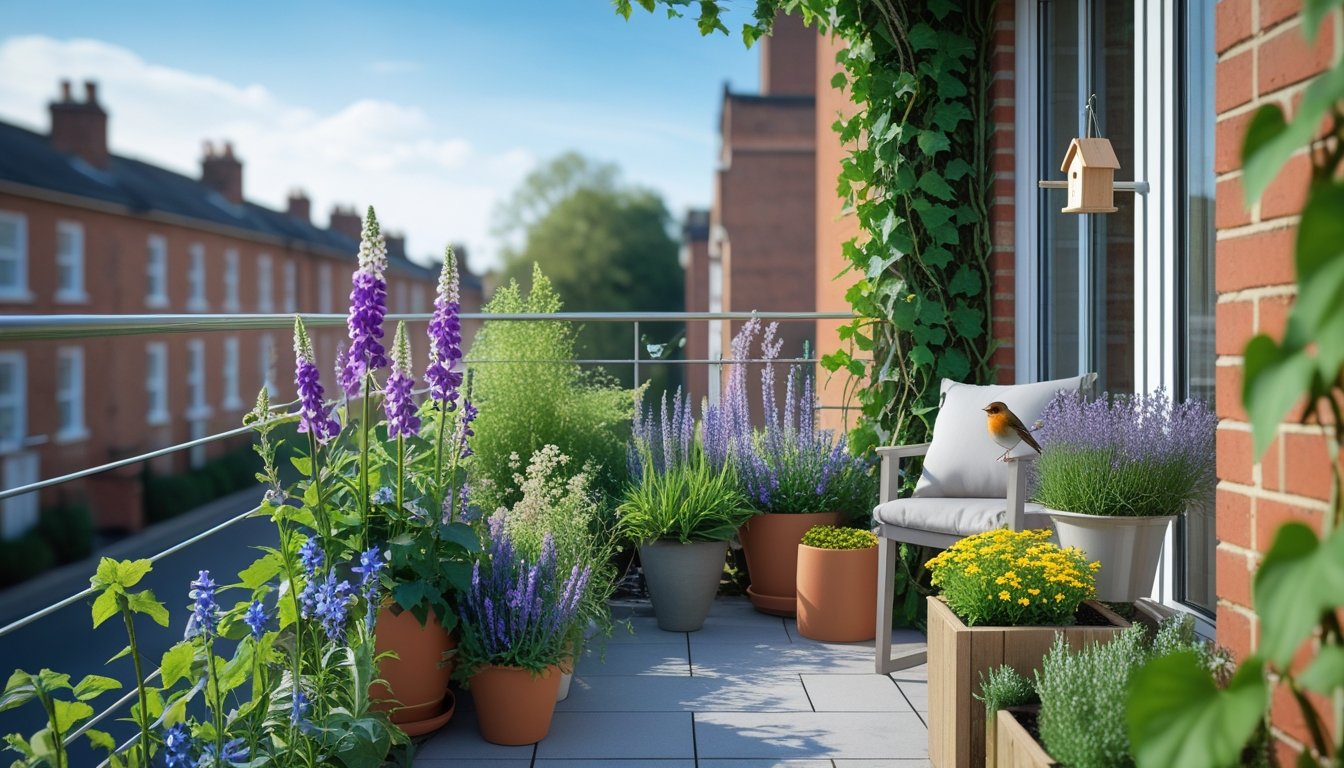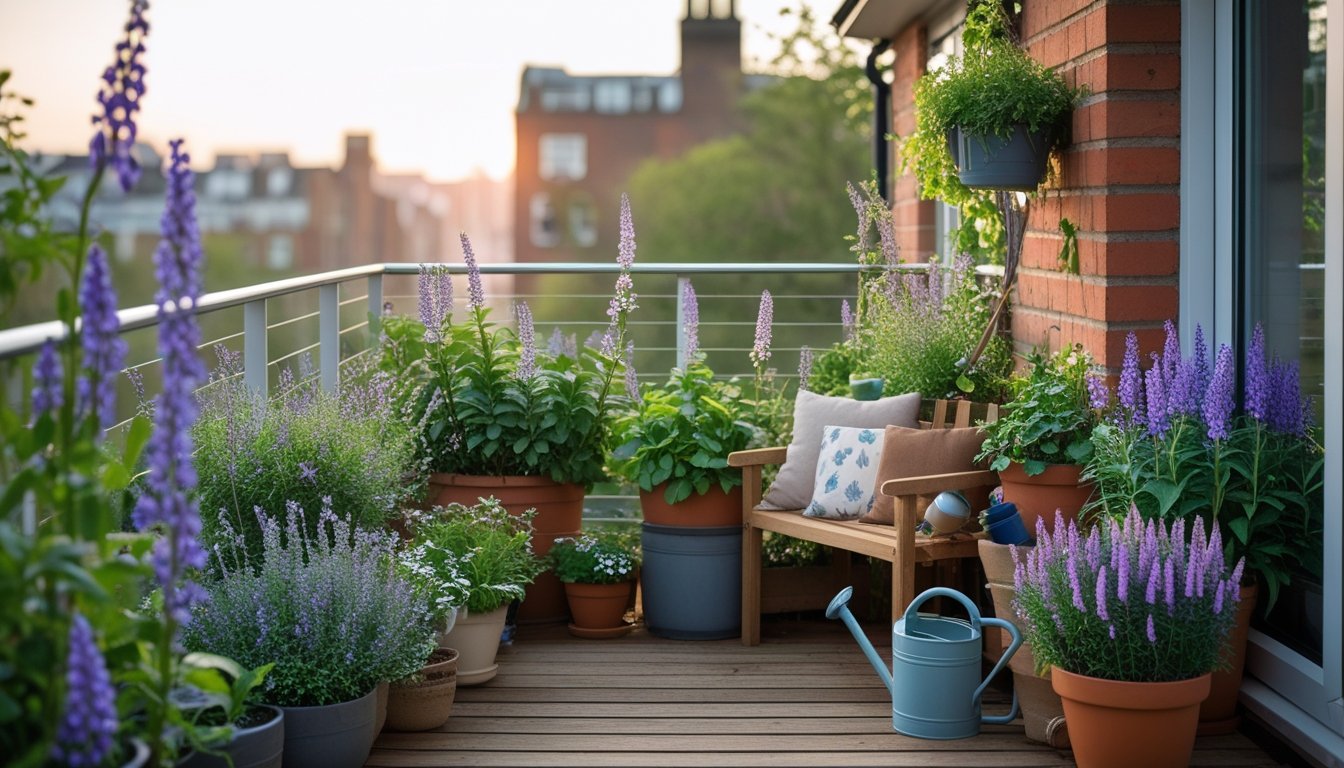Late updated: 21 Oct 2025 08:10
Written by: Emily Thornton
How To Create A Native UK Garden On A Balcony: Expert Tips For Urban Spaces
Transforming a balcony into a native UK garden may seem challenging, but it offers exceptional opportunities for both aesthetics and biodiversity. The key to success lies in selecting the right native plants that not only thrive in the unique conditions of a balcony but also support local wildlife. Embracing local flora ensures that your vertical garden is in harmony with the surrounding ecosystem, inviting butterflies, bees, and birds to your urban haven.

By observing your balcony's microclimate—its sunlight, wind patterns, and space limitations—we can determine the best approach to planting. Small spaces can still offer a range of design possibilities, enabling us to create lush, layered environments that captivate the eye and encourage biodiversity. Lightweight planters and smart layouts will help us maximise every inch without compromising on aesthetics or sustainability.
Creating a vibrant balcony garden is not only about visual appeal but also about giving back to nature. In addition to supporting pollinators, your garden can also become a source of fresh herbs or small vegetables, providing fresh flavours right at your doorstep.
Key Takeaways
- Choose native plants that suit your balcony's conditions.
- Use lightweight planters to make the most of your space.
- Create a space that supports local wildlife and offers edible benefits.
Key Steps for Creating a Native UK Balcony Garden
Transforming a balcony into a native garden requires thoughtful planning. We explore assessing your space, choosing the right plants, arranging containers, and ensuring healthy soil and watering practices. Each step focuses on creating a sustainable and thriving environment with native plants.
Assessing Your Outdoor Space and Conditions
First, we must assess our balcony's conditions. Understanding the direction it faces can determine the amount of sunlight it receives. A south-facing balcony offers more sunlight, which is ideal for many native plants, while a north-facing one might suit shade-tolerant varieties.
Wind exposure is another critical factor. Balconies on higher floors can be windy, requiring us to consider windbreaks or sturdy plants. Utilising structures like trellis can also provide additional shelter and support climbing plants. The available space dictates the number and size of containers we can accommodate.
Taking these elements into account will help us create a thriving native garden that adapts well to our unique balcony environment.
Selecting Suitable Native Plants for Balconies
Choosing the right native plants for our balcony involves considering climate, light, and space constraints. UK native plants like foxgloves, primroses, and shrubs such as hawthorn provide beauty while supporting local wildlife. It's essential to select drought-resistant varieties that can tolerate the UK's variable weather.
Incorporating a mix of perennials and annuals can ensure year-round interest and support local pollinators. Herbs like thyme and mint not only add fragrance but are also useful culinary additions. It's useful to research plant heights and spread to maintain a balanced visual appeal and avoid overcrowding.
Armed with this knowledge, we can select plants that create a vibrant and sustainable balcony garden.
Choosing Containers, Hanging Baskets, and Arranging Layout
Containers and hanging baskets are vital in maximising our use of space. Terracotta pots and biodegradable containers add aesthetic appeal, while vertical planters are excellent for limited spaces. Hanging baskets can utilise overhead space, allowing us to grow trailing plants or additional flowering species.
When arranging our layout, it's vital to balance aesthetics with practicality. Placing taller plants at the back and compact ones at the front ensures even sunlight distribution. Grouping plants based on their moisture and light needs simplifies care routines and optimises plant health.
This thoughtful arrangement leads to a cohesive balcony garden that enhances both beauty and functionality.
Soil, Compost, and Watering Best Practices
Healthy soil is crucial for our plants' growth. Using a quality potting mix with added compost provides essential nutrients and improves drainage. We recommend incorporating organic matter like leaf mould or well-rotted manure to enrich the soil further.
Proper watering is vital. Overwatering or underwatering can harm plants, so monitoring soil moisture is key. Utilizing self-watering systems or employing a watering schedule aids in maintaining consistency, especially during dry spells.
Understanding these practices ensures our balcony plants receive the nutrition and moisture they need to flourish.
Maximising Wildlife and Edible Potential in Your Balcony Garden
To create a thriving balcony garden in the UK, we can focus on attracting pollinators, growing native herbs, and maintaining year-round biodiversity. By integrating wildlife-friendly plants and edible species, we can transform our balcony into a vibrant ecosystem.
Attracting Pollinators and Supporting Local Wildlife
Our balcony can provide a crucial habitat for local wildlife by attracting pollinators like bees and butterflies. We can plant Buddleia, also known as the butterfly bush, which blooms with clusters of flowers that pollinators love.
Additionally, using native wildflowers supports the survival of local species. Offering water sources, such as shallow dishes with stones, helps birds and insects gather safely. Avoiding pesticides is vital to ensure the safety of visiting wildlife.
Growing Native Herbs and Edible Plants
Incorporating native herbs and edible species such as thyme, rosemary, and lettuce gives us fresh ingredients while promoting biodiversity. These plants are well-suited to the UK climate and can be grown in containers or window boxes.
Thyme and rosemary thrive in sunny spots and require minimal maintenance. Lettuce varieties can be grown alongside these herbs, offering vibrant leaves for salads. By choosing native species and companion planting, we optimise space and enhance the resilience of our garden.
Encouraging Year-Round Interest and Biodiversity
To maintain year-round interest, we need to select plants that bloom or provide greenery in different seasons. This helps sustain wildlife and keeps our garden attractive all year.
Evergreen herbs like rosemary offer colour during winter months, while other species can be rotated seasonally. Installing bird feeders or nesting boxes encourages diverse fauna. Emphasising layers, such as combining taller and trailing plants, increases habitat variety and can transform our balcony into a biodiversity hotspot. By implementing these strategies, we ensure our garden remains lively and supportive of local ecosystems throughout the year.
Frequently Asked Questions

When setting up a native UK garden on a balcony, it's important to select plants that thrive in small spaces, support local wildlife, and can adapt to container life. This involves understanding plant needs, space constraints, and seasonal maintenance.
What are the best native UK plants for cultivating in a balcony garden?
Choosing the right plants is essential. Consider species like primroses, foxgloves, and heather for vibrant blooms. These plants not only add colour but also thrive in the UK climate and often require minimal care.
How can one attract and support local wildlife on a small balcony garden?
Utilising native plants such as wild marjoram and harebell can draw pollinators like bees and butterflies. Including small water features or bird feeders can further enhance the habitat for a variety of creatures.
What considerations should be made for container gardening with indigenous UK species?
Selecting the right size and type of containers is crucial. Containers must have good drainage to prevent waterlogging. Group plants with similar water and sunlight needs to create microhabitats that can sustain multiple species efficiently.
Could you suggest a design layout for a native UK plant balcony garden?
Arrange taller plants like foxgloves towards the back or sides to maximise sunlight exposure. Use hanging baskets for creeping plants like ivy to create layers. Incorporate a mix of flowering plants for seasonal interest and textural contrast.
What are the ideal soil types and conditions for growing native UK plants in containers?
Loamy soil with good drainage is often best for UK native plants. Enriched with organic matter, the soil should retain some moisture. Ensure regular watering during dry spells and adjust based on plant requirements and seasonal changes.
How can one maintain a native UK balcony garden throughout the changing seasons?
Regular pruning is vital to encourage growth and maintain plant health. During the cooler months, insulating containers can protect roots from frost. Consider seasonal planting to ensure year-round visual interest and ecological benefit. Maintenance routines might need adjusting to account for differing seasonal challenges.
